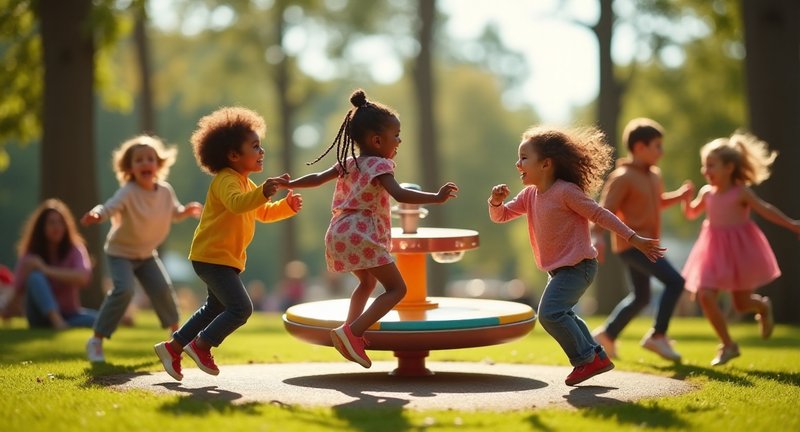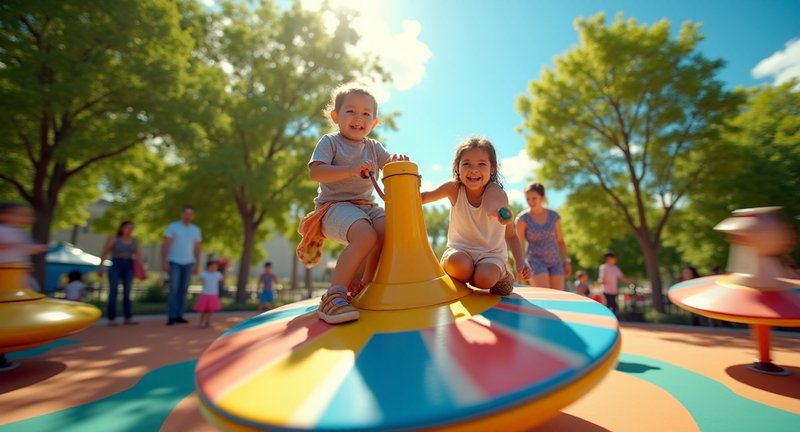Introduction to Spinning Playground Equipment
Spinning Playground Equipment is where I spent countless childhood hours, a dizzying whirl of excitement and fun. From carousels to merry-go-rounds, these kinetic wonders have been staples in parks for generations. They’re a perfect mix of simplicity and thrill what could be better than defying gravity, if only for a few seconds?
As a kid, I remember the rush of jumping on a spinning platform, heart racing, and holding on for dear life as it gained speed. There’s something deeply satisfying about controlling that motion, like you’ve unlocked a secret to how the world moves. And then, of course, the inevitable stumble afterward giggling through that delightful, disorienting dizziness.
What’s fascinating about Rotating playground equipment is how it invites everyone in. It’s not just for kids teens, and even adults, sneak in a turn or two when the coast is clear. You don’t need special skills; all it takes is the willingness to let go and feel the wind tugging at your clothes as you spin faster and faster.

But it’s more than just fun. Spinning playgrounds are dynamic tools for developing balance and coordination. They’re like a mini carnival for the senses, offering moments of joy and a subtle boost to motor skills. It’s why they’re not only a playground favorite but also cherished memories for so many of us who grew up with them.
So, next time you see one, I encourage you give it a whirl. You might be surprised at how quickly the nostalgia kicks in, pulling you right back into the swirling, carefree world of your childhood.
The Joy of Spinning Playground Equipment
As a child, there was nothing quite like the rush of wind in my face as I clung to the edge of a merry-go-round or roundabout, spinning faster and faster, feeling as if the whole world was in motion. The beauty of those rotating playground attractions lies not just in their simple design but in the joy they inspire. These twirling structures tap into something primal, a delight in motion that connects us to the natural rhythms of the world around us.
What I love most about this kind of experience is how it caters to different moods:
-
Need for speed: When you’re feeling bold, a good, vigorous spin can offer a sense of thrill, almost like a rollercoaster without the high-tech fuss.
-
Seeking serenity: On the other hand, a slower turn lets you enjoy the sensation of weightlessness, a quiet dance with gravity as the world sways gently around you.
-
Group fun: Whether you’re with friends or strangers, there’s something special about sharing this ride. Everyone takes turns pushing, laughing, and bracing themselves for the next whirl. It’s communal, but each rider gets a unique experience.
And then there’s the physicality of it holding tight, using your muscles to either speed things up or slow them down. It’s a full-body interaction with joy itself.

Next time you find yourself near one of these classic playground staples, don’t pass it by. Give it a go, even if just for a moment, and let yourself reconnect with that carefree feeling we all crave.
Introduction to Spinning Play Features
Let me take you on a little journey into one of the most exhilarating aspects of any play area the spinning play features. You know the type I’m talking about. The moment you step onto one, there’s this thrilling mix of excitement and anticipation as you feel the world start to whirl beneath you.
These features do more than just entertain they challenge balance, coordination, and spatial awareness. From my own experience, watching kids take their first spin often feels like witnessing them unlock a new level of confidence. They might wobble, lose their footing at first, but give them a moment, and suddenly they’re whizzing around like pros, grinning ear to ear.
Here’s what I love about them:
-
Engagement through Movement: Spinning is fun, but it’s also an active way to engage muscles and develop motor skills. It’s like a workout disguised as fun, which is the best kind, right?
-
A Variety of Designs: Some have seats or platforms, while others challenge you to stand or balance. The variety keeps things fresh no two spins are quite the same.
-
Social Play: Many of these features encourage group interaction. There’s a certain camaraderie when kids or even adults take turns pushing each other or competing to stay balanced the longest.
-
Sensory Stimulation: The spinning motion is more than just a thrill; it stimulates the vestibular system, which helps with balance and body control.
If you haven’t yet taken a turn on one of these, I highly recommend it. Trust me, it’s not just for kids it’s a rush for anyone willing to hop on!
Benefits of Rotational Play Structures
One of the most underrated joys in any park or playground is the thrill of rotational play structures. From my own experience, these are more than just simple pieces of equipment – they are little portals into a world of excitement, laughter, and coordination development. You may have seen kids (and let’s be honest, adults too) spinning around endlessly, grinning ear to ear, but there’s more going on beneath the surface than just fun.
Balance and Coordination Boost:
When kids engage with rotational play structures, they’re developing motor skills without even realizing it. The constant shifting forces them to adjust their posture, improving their balance and enhancing coordination. It’s like a secret workout for their muscles and mind, helping them build spatial awareness in a thrilling way.
Social Connection:
Let’s talk about how these play structures naturally bring kids together. Whether it’s taking turns, spinning each other, or sharing tips on how to hold on the longest, rotational play fosters interaction. This leads to teamwork, communication, and sometimes even new friendships. Who knew something as simple as a spinning structure could be a social magnet?
Sensory Stimulation:
There’s something almost mesmerizing about the spinning motion. It engages the vestibular system, which controls balance and spatial orientation. This type of sensory input helps children process movement, and can even be calming for some. The gentle swirls can have a soothing effect, almost like rocking a baby to sleep – but with way more giggles involved.
Exercise Disguised as Fun:
Rotational structures also encourage physical activity in a way that doesn’t feel like exercise. The act of pushing, pulling, and holding on activates muscles in the arms, legs, and core, all while giving the cardiovascular system a boost. Who needs a gym when the playground offers such thrilling workouts?
Confidence Builder:
Mastering the art of controlling speed and direction on a rotational structure can give kids a sense of accomplishment. Every time they successfully hold on or spin faster than before, they gain a little more confidence in their abilities.
Next time you see one of these in action, you’ll know it’s more than just a fun ride – it’s a powerhouse for physical, social, and emotional growth.
Different Types of Spinning Equipment
When you dive into the world of spinning, you’ll quickly realize how vast and varied the equipment can be. First up, you’ve got the traditional spinning wheels. These beauties, often made from wood, offer a tactile experience that connects you directly to centuries-old methods of crafting yarn. They’re a bit like stepping into a time machine, where your hands are both the motor and the mind behind every twist of fiber.
Then there’s the modern-day answer to those wheels – electric spinners. With the hum of a motor, they take some of the physical work out of the equation. You can adjust the speed, sit back, and focus on the quality of your yarn, rather than worrying about maintaining momentum. It’s like having a reliable companion who always keeps the pace for you.
For those of us who crave something portable, spindle spinning is a must-try. A drop spindle is simple, yet mesmerizing. You spin the spindle with a flick of your fingers, letting gravity do most of the work as it hangs in mid-air. It’s the type of equipment you can pop into your bag, allowing you to spin anywhere – whether that’s on the bus or by a cozy fire.
Also, don’t overlook the supported spindle. Unlike the drop spindle, this one stays grounded, resting on a bowl or surface. It’s slower, more meditative, but ideal for delicate fibers that demand patience and precision. The process feels like a gentle dance between your fingers and the fibers, coaxing them into the perfect twist.
There’s no one-size-fits-all with spinning equipment, so explore, experiment, and find what speaks to your crafting soul.
Safety Considerations for Rotating Play Gear
In the context of any type of rotating play gear, safety is a big deal. The thrill of movement is exciting, but it’s also where risks can sneak up on you. I’ve seen this firsthand, watching kids eagerly hop on and spin away without thinking twice. That’s why keeping an eye on potential hazards is key.
One of the first things I always check is the surrounding area. Is there enough space for a safe landing if someone slips off? Trust me, a fall on hard concrete is a world away from a gentle tumble onto grass or mulch. If you’re like me, you’d prefer soft landings.
Another often-overlooked factor is speed. Not just how fast the equipment goes, but how fast it’s being used. Kids tend to push their limits (I know I did!), so it’s crucial to show them how to play in a way that’s fun but not reckless. You want excitement, not injuries.
Also, pay attention to the condition of the gear itself. Rusty joints or loose bolts? No thanks! Regular checks can prevent accidents before they happen. A little maintenance goes a long way.
And lastly, supervision. It’s tempting to stand back and let them whirl around, but a watchful eye can make all the difference. I like to think of it as quietly being the safety net they don’t even realize is there.
Age Appropriateness for Spinning Toys
In the matter of spinning toys, understanding age appropriateness is key. I’ve spent quite a bit of time observing and even participating in different age groups engaging with these whirlwind gadgets. Here’s what I’ve learned: not all spinning toys are created equal, and the experience for a toddler is quite different from that of a teenager.
For Toddlers (Ages 2-4)
At this early stage, balance and coordination are just starting to develop. Spinning toys for toddlers need to be low to the ground and easy to grip. Think about things like:
- Simple spinning tops – easy for small hands to spin without tipping over.
- Sit-and-spin toys – a perfect introduction to twirling in a safe, controlled way.
For Children (Ages 5-8)
Kids in this age range are starting to crave a bit more excitement. They’re eager to experiment with speed but still need safety features.
- Gyroscope-style spinners – these add a bit of challenge without requiring too much coordination.
- Twist-and-turn toys – a step up in complexity, providing hours of entertainment as they figure out the mechanics.
For Pre-teens and Teens (Ages 9-15)
Now we’re talking about kids with more advanced motor skills and a taste for thrill. They seek out toys that test their limits:
- High-speed spinning gadgets – for the more adventurous, they offer an adrenaline rush.
- Balance-based spinners – these toys bring in elements of challenge and strategy, keeping older kids and teens engaged.
So, whether you’re buying for a toddler or a teen, the right spinning toy can make a world of difference. Just keep in mind the level of coordination, safety, and fun that matches their age. Trust me, you don’t want to give a five-year-old something made for a fifteen-year-old chaos will ensue!
Materials Used in Rotational Playground Items
When we think about rotational playground items, the materials they’re made from play a huge role in durability and performance. I’ve spent a fair amount of time observing these in different playgrounds, and it’s clear that the materials need to withstand heavy use while still being safe and comfortable for children.
Most commonly, metals are used as the foundation. Stainless steel, in particular, is highly valued for its strength and resistance to weathering. It’s the reason why those pieces seem to last through all seasons without rusting or losing their luster. Another advantage of metal is how well it can be shaped to create smooth, rounded surfaces that are less likely to cause injury.
Next, let’s talk about plastics polyethylene is a standout material here. It’s lightweight yet tough, perfect for forming seats or barriers where kids will be in contact. The best part? It’s often UV-resistant, meaning it won’t fade under the sun’s harsh rays. Plus, it’s smooth to the touch, which is great when you think about how many little hands will be all over it.
Here’s a material you might not immediately think of: rubber. Rubber-coated components are a lifesaver for safety. I’ve seen this used on handgrips or foot platforms, and it significantly reduces the chance of slipping. It’s flexible but still strong enough to provide stability where it counts.
Also, composite materials are gaining popularity. These are combinations of different materials like fiberglass and plastic, which blend the strengths of each strong, flexible, and lightweight. You’ll find these in newer playground setups, where innovation is key.
So, whether it’s stainless steel for structure, polyethylene for comfort, or rubber for safety, the materials used in these playground pieces are all about creating a fun, safe experience that lasts.
Design Options for Spinning Play Equipment
With respect to crafting an exciting outdoor play area, one thing I’ve learned is that spinning structures never fail to thrill. From design options that look like they came from a futuristic movie set to more classic, minimalist styles, there’s a lot to think about when choosing the perfect spinner.
Materials That Matter
First up, think about what it’s made from. Durability is key because we all know how rough kids can be on these things! You’ll find some great designs using heavy-duty plastic, which keeps things lightweight yet sturdy. Then there’s metal while a little heavier, it brings a sleek, industrial feel and can take a beating from weather or rough play without a scratch.
- Heavy-duty plastic: Lightweight, easy to clean, and colorful.
- Powder-coated metal: Long-lasting, weather-resistant, and modern.
- Wood accents: For a more natural vibe that blends into park environments.
Size and Shape: Spinning for All Ages
You might be thinking, ‘Does size really matter?’ Oh, it absolutely does. Smaller spinners cater to younger kids, while larger, multi-user ones are designed for bigger groups, fostering social play. A wide base for stable spinning or a narrow central column for quick twirls the possibilities are endless.
- Single-user spinners: Ideal for toddlers or solo adventures.
- Multi-user models: Perfect for groups and creating that shared joy of a good spin.
- Inclusive designs: Lower platforms and accessible seating allow everyone to join in the fun.
Colors and Themes
Also, let’s not forget the impact of color. A bright, vibrant spinner can act as a beacon of joy in any play area, while earth-toned designs offer a subtle, calming appeal. Personally, I love when play equipment becomes a work of art there are even themed spinners out there shaped like flowers, rockets, or whirlpools!
Whatever design path you choose, remember that the ultimate goal is to create a space where laughter and creativity take center stage.
Space Requirements for Rotating Structures
With a focus on designing play areas, one of the most delightful yet challenging aspects is figuring out the space requirements for rotating structures, particularly spinning playground equipment. As a parent who’s navigated the colorful chaos of playgrounds, I can tell you that ensuring enough room for these whimsical installations is crucial for safety and enjoyment.
Here are some key considerations based on my experiences:
-
Safety Zones: Always allow for a safety perimeter around spinning equipment. This space helps prevent collisions and gives kids the freedom to play without the fear of bumping into something solid.
-
Equipment Size: Different spinning structures come in various sizes. A small, single-axis spinner might need less space than a large, multi-user carousel. Be sure to check manufacturer guidelines for specific spatial requirements.
-
User Capacity: Think about how many children will be using the equipment at once. More users generally require more space to move around, spin, and dismount safely.
-
Surface Type: The ground beneath these structures matters. Soft surfaces like rubber mulch or grass can cushion falls, but they may also need more room for the equipment’s installation.
-
Accessibility: Don’t forget about inclusivity! Make sure that there’s adequate room for children of all abilities to access and enjoy the rotating play structures.
Designing these spaces isn’t just about fitting things in; it’s about creating an environment where laughter and joy can flourish. The best playgrounds are those that allow kids to spin, twirl, and tumble without a care in the world while we parents watch on, perhaps with a chuckle or two at the sheer exuberance of childhood.
Installation Tips for Play Areas
In the matter of creating a whimsical play area, installation is where the magic begins. I’ve always found that a little foresight and planning can make a world of difference. Here are some tips I’ve gathered over the years to help you install play equipment that promises not just fun but also safety and longevity.
1. Choose the Right Location:
- Look for a flat surface; nobody wants a tilt-a-whirl experience!
- Consider sun exposure; play areas in the shade can keep equipment cool and kids happy.
- Ensure there’s enough space for kids to run freely nothing feels worse than cramped quarters.
2. Secure Your Equipment:
- Dig deep! Create sturdy foundations by burying posts at least a foot deep in concrete.
- Use ground anchors for any freestanding structures to withstand enthusiastic play.
3. Safety First:
- Install soft surfaces like mulch or rubber mats beneath play equipment to cushion any tumbles.
- Ensure all equipment has rounded edges; sharp corners can lead to unexpected scrapes.
4. Maintenance Matters:
- Regularly check for loose bolts and screws; nothing spoils the fun like a wobbly swing.
- Keep an eye on wear and tear; replace any frayed ropes or faded parts.
5. Personal Touches:
- Get creative! Add colorful paint or themed decorations to spark joy and imagination.
- Think about accessibility; consider equipment that everyone can enjoy, including children with different abilities.
Remember, setting up a play area isn’t just about installation; it’s about crafting a space where laughter thrives and adventures are born. Dive in with enthusiasm, and watch as your dreams for a perfect play paradise come to life!
A Comprehensive Guide to Spinning Playground Equipment
As I strolled through the local park, I was irresistibly drawn to the whimsical world of twirling play structures. These marvelous contraptions have an almost magnetic charm that beckons children and adults alike to indulge in the dizzying delights of motion.
Watching kids leap onto these colorful whirlers, I couldn’t help but smile. It reminded me of my own childhood adventures, where the thrill of spinning felt like a rite of passage. There’s something uniquely joyful about letting go, feeling the rush of wind against your face, and surrendering to the centrifugal forces of fun.
These twirling wonders are not just about exhilaration; they’re a delightful blend of physical activity and social interaction. Children can bond over the shared experience of spinning, laughing, and trying to maintain their balance. It’s a dance of camaraderie that fosters friendships and memories that last a lifetime.

If you’re considering adding one of these vibrant devices to your local playground or backyard, think about the design and safety features. Opt for equipment that encourages imaginative play while ensuring sturdy construction. After all, the aim is to create a safe haven for laughter and delight, where kids can express their adventurous spirits.
In my experience, introducing a spinning structure can transform a mundane playground into a vibrant oasis of excitement. It’s an invitation for exploration, creativity, and, most importantly, pure joy. So, the next time you encounter one of these enchanting devices, don’t hesitate to jump in and join the fun!
Maintenance Guidelines for Rotational Equipment
Considering maintaining rotational equipment, there’s more to it than just the occasional wipe down or a bit of lubrication. From my own experiences, I’ve learned that regular upkeep not only prolongs the life of the equipment but also ensures a safer, more enjoyable experience for everyone involved. Here’s a concise guide to keeping that equipment spinning smoothly and safely.
Routine Maintenance Checks:
- Visual Inspections: Regularly inspect for wear and tear. Look for frayed cables, cracks, or rust. If something looks off, it probably is.
- Lubrication: Apply appropriate lubricant to moving parts to keep everything gliding along smoothly. Just don’t overdo it too much grease can attract dirt.
- Tightening Bolts: Equipment vibrates, and bolts can loosen over time. Grab a wrench and give them a quick check every few weeks.
Seasonal Deep Cleans:
- Power Washing: A thorough clean can do wonders. A good spray can remove accumulated dirt and grime that dulls the surface and may hide problems.
- Inspect Anchors: Check the anchors and ground connections, especially after harsh weather. Ensure everything is secure to prevent any unwelcome surprises.
Safety Protocols:
- User Guidelines: Make sure everyone knows the do’s and don’ts. Clear signage helps keep things safe and fun.
- Emergency Plans: Have a response plan in place in case something goes awry. Better to be prepared than caught off guard.
By incorporating these simple yet effective maintenance practices, you can ensure that rotational equipment remains a source of joy rather than a point of frustration. Trust me; your future self will thank you!
Cost Factors in Choosing Spinning Toys
As it relates to choosing the right spinning toys for our little whirlwinds, cost factors can feel like a merry-go-round of decisions. I remember my first foray into selecting these delightful additions for our backyard it’s a mix of excitement and bewilderment. Here’s how to navigate those swirling expenses.
First off, consider the quality of materials. Higher-quality spinning toys may cost a bit more upfront, but they often outlast cheaper alternatives. Think of it this way: investing in durable materials can save you from recurring costs down the line. Here are some aspects to ponder:
- Material type: Look for weather-resistant and non-toxic options.
- Safety certifications: Ensure they meet safety standards to avoid any unexpected surprises.
- Warranty and support: A good warranty can be a lifesaver if anything goes awry.
Next, think about installation costs. Some spinning toys come as ready-to-go kits, while others might require professional installation. This can add a significant amount to your budget. A few things to keep in mind:
- DIY options: Are you handy? Installing it yourself could save you some cash.
- Professional help: Weigh the cost of hiring someone versus the peace of mind it might bring.
As a matter of fact, don’t overlook maintenance and upkeep. Just like any cherished toy, spinning contraptions require care. Factor in:
- Regular inspections: To ensure everything spins safely and smoothly.
- Replacement parts: Having a budget for spare parts can prevent a minor issue from turning into a costly fix.
By keeping these considerations in mind, you can enjoy the thrill of spinning toys without the dizzying financial hangover. Happy spinning!
Enhancing Social Interaction with Rotating Equipment
When I think of the joy that comes from rotating equipment, I’m often reminded of laughter echoing through the air. It’s incredible how a simple act of spinning can ignite a sense of connection among friends and family.
These whimsical contraptions serve as magnets for social interaction. Children and adults alike find themselves drawn to the joyous whirl, engaging in playful banter and shared experiences. The shared laughter becomes a melody, harmonizing the joys of friendship and community.
In my experience, there’s something magical about watching people come together around such devices. Whether it’s the thrill of competition or the pure enjoyment of spinning together, these moments foster camaraderie. It’s like stepping into a different world where time seems to pause, and worries melt away.
Even a casual gathering can transform into a vibrant social affair. People naturally gravitate towards the thrill, making new friends and reconnecting with old ones. It’s fascinating how these experiences often spark conversations that linger long after the spinning stops.
Furthermore, these dynamic pieces of equipment are not just for the young at heart. I’ve seen adults rediscover their childlike spirit, releasing stress and embracing the exhilaration of movement. It’s a reminder that we all deserve a little joy, regardless of age.
So, next time you see one of these delightful gadgets, don’t hesitate to join in the fun. You’ll be surprised at how a few rotations can create lasting memories and strengthen bonds.
What You Need to Know
What is the spinny thing on the playground called?
The spinny thing on the playground is often referred to as a ‘spinner’ or ‘spinning disk.’ These devices are designed for children to enjoy a fun and exhilarating experience as they rotate. Depending on the design, they may be flat, raised, or have a central pole for kids to hold onto. Spinners come in various shapes and styles, providing different spinning sensations. They are popular for encouraging social interaction and helping kids develop balance and coordination skills while having fun.
What playground equipment spins?
Various types of playground equipment are designed to spin and provide children with exhilarating experiences. Common examples include merry-go-rounds, spin discs, and whirlers. Merry-go-rounds have a rotating platform where kids can either run alongside or hop on and enjoy the spinning motion. Spin discs allow children to sit or stand while spinning themselves or being spun by their friends. Whirlers typically feature a central axis where kids hold on and enjoy the sensation of spinning around in a circular motion.
What is the playground equipment that goes around in circles?
The playground equipment that goes around in circles is typically called a ‘merry-go-round.’ This equipment usually features a circular platform that rotates around a central axis, allowing children to sit or stand on it while it spins. Merry-go-rounds can be made from various materials, including metal or plastic, and often come equipped with handrails for safety. They are designed to promote physical activity and social interaction among children, providing a fun way to enjoy time together at the playground.
What is the spinning circle at the playground?
The spinning circle at the playground is commonly known as a ‘spinner’ or ‘spin disc.’ This piece of equipment usually features a flat, circular platform that spins around a central point, allowing children to sit or stand while enjoying the motion. Some designs allow kids to create their own spinning speed by using their feet or arms to push off the ground. These spinners encourage active play, promote social interaction, and help children develop their balance and coordination skills.
What are those spinny things called?
Those spinny things on playgrounds are generally referred to as ‘spinners.’ This term encompasses various types of rotating playground equipment, including merry-go-rounds, whirlers, and spin discs. Each of these devices allows children to experience the fun of spinning while engaging in physical activity. The design and mechanism of spinners can vary widely, providing different levels of excitement and interaction for kids. Spinners play an essential role in fostering social play and helping children develop motor skills.
What do Americans call Merry Go Rounds?
In the United States, ‘Merry-Go-Round’ typically refers to a specific type of playground equipment that features a circular platform that rotates around a central axis. However, some regions may also use terms like ’roundabout’ or ‘carousel’ interchangeably. These devices allow children to sit or stand while spinning, promoting social interaction and active play. It’s important to note that the terminology can vary by region, but the fundamental design and purpose remain consistent across different terms.
What is the spinning toy called?
The spinning toy commonly found on playgrounds is often referred to as a ‘spinner’ or ‘spin toy.’ These toys come in various designs and sizes, allowing children to experience the thrill of spinning in a safe environment. Some spinners are designed for multiple children to use at once, encouraging social play and interaction. The motion of spinning can be exhilarating for kids, providing them with a fun way to develop balance and coordination while enjoying their time outdoors.
What is the most popular playground equipment?
The most popular playground equipment often includes swings, slides, and climbing structures. However, spinners have gained significant popularity due to their unique and exciting play experiences. Swings are favored for their ability to promote physical activity and provide a calming, rhythmic motion. Slides attract children with their thrilling descent, while climbing structures encourage exploration and physical fitness. Spinners add a dynamic element to playgrounds, allowing children to engage in interactive play and socialization, making them a favorite among kids.
How do playground spinners work?
Playground spinners work by utilizing a central pivot point that allows the platform to rotate freely. Children can either sit, stand, or hold onto the spinner while using their body weight or foot movements to initiate spinning. Some spinners are designed to be spun by other children, creating a collaborative play experience. The friction between the spinner and its base is typically minimized to allow for smoother, faster spins. Safety features, such as handrails and non-slip surfaces, are often incorporated to enhance the fun while ensuring children’s safety during play.
What is the Merry-Go-Round on a playground called?
The Merry-Go-Round on a playground is often simply called a ‘merry-go-round,’ though some may refer to it as a ‘carousel.’ This equipment consists of a circular platform that rotates around a central axis, allowing children to sit or stand while enjoying the sensation of spinning. While the term ‘carousel’ is more commonly associated with amusement park rides featuring decorative animals, playground merry-go-rounds serve a similar purpose in promoting active, social play for children at parks and playgrounds.
What are the names of playground equipment?
Playground equipment encompasses a wide variety of structures and devices designed for children’s play. Common names include swings, slides, seesaws, climbing frames, monkey bars, merry-go-rounds, spinners, and sandbox structures. Each piece of equipment serves a specific purpose, promoting different types of physical activity and imaginative play. Additionally, there are often themed play structures that encourage creative exploration, and many parks include safety features like soft ground surfaces to protect children during their playtime adventures.
What is the stuff on the ground of playgrounds called?
The material on the ground of playgrounds is commonly referred to as ‘playground surfacing.’ This surfacing serves several purposes, including providing a safe landing area for children playing on equipment, reducing the risk of injuries from falls, and enhancing overall accessibility. Playground surfacing materials can include rubber mats, wood chips, mulch, sand, or synthetic turf, each with its own benefits and maintenance considerations. Proper surfacing is crucial for ensuring a safe play environment and is often a requirement in playground design and installation.











I couldn’t agree more with the need for careful installation planning! Picking the right spot for a play area is crucial shade is such a lifesaver during summer months. My nephew once burnt his hands on playground equipment that had been baking in the sun for hours. Since then, I’ve always advocated for setting up in shadier areas. Plus, it makes the space so much more enjoyable when kids aren’t running off to cool down every few minutes. When it comes to securing the equipment, I’ve learned the hard way about skipping the proper anchoring process. I once helped set up a swing set that started wobbling after just a few days because we didn’t dig the posts deep enough into the ground. We had to go back, re-dig, and do it properly it was a lesson in patience! I also love your point about adding personal touches. Colorful designs or quirky little decorations can make a world of difference in turning a standard play area into a place where kids feel inspired to let their
I can totally relate to this! As a parent who has spent countless hours chasing after my little ones in various playgrounds, figuring out space for spinning equipment is no joke. Safety zones around these things are so important, especially when kids get super excited and don’t always pay attention to their surroundings. I remember this one time my daughter nearly collided with another kid while both were trying to get off a carousel yikes! Having a soft surface like mulch or grass under the equipment definitely adds peace of mind too. Love the point about inclusivity! It’s easy to forget, but making sure play spaces are accessible to everyone is key. In the end, watching kids spin around with sheer joy makes all the planning and considerations worth it. There’s something magical about those moments when they’re lost in the fun, and we’re there to soak it all in. Thanks for the great tips!
I love that you brought up how design can really set the tone for a play area! It’s amazing how much variety there is in spinning structures now. I’m personally a fan of the multi-user spinners because nothing beats watching a group of kids laugh together as they try to keep their balance. It’s also really important to consider inclusivity, like you mentioned. Playgrounds should be places where every kid feels welcome, and it’s fantastic that designers are thinking about accessible seating. Plus, the colors and themes part hit home for me I live near a park that has these bright, flower-shaped spinners, and they just light up the whole space. It’s great when play equipment is functional but also fun to look at! Definitely gives the playground an extra layer of creativity and excitement.
It’s so true! The choice of materials really makes all the difference. I’ve noticed how the metal playground equipment in my neighborhood stays looking new year after year especially the stainless steel. It’s practically indestructible. I’m also a huge fan of polyethylene for kid-friendly surfaces. Not only is it durable, but it’s so smooth and comfortable to the touch, which is a big deal when kids are constantly climbing and touching everything. And yeah, rubber is a game-changer for safety! Great breakdown of all the options.
Wow, this really brings back memories! I used to be obsessed with spinning tops as a kid, and now that I have a toddler of my own, I’m starting to see how important it is to choose the right kind of toy. I totally agree that toddlers need something simple and safe like sit-and-spin toys. My daughter is just getting the hang of those, and it’s been such a fun (and safe!) way for her to explore balance and coordination. But I hadn’t thought much about how different the experience is for older kids! I can already imagine her wanting something more challenging as she grows. It’s wild how much difference a few years can make those high-speed spinners for teens sound intense! I love how you’ve broken down the types of spinners by age group. It’s like you’re handing out a cheat sheet for parents who want to buy something fun but safe at the same time. Definitely bookmarking this for the future because, honestly, spinning toys are timeless. Every kid goes through that phase whe
You make such a great point about safety! It’s easy to get caught up in the fun of the moment and forget about the risks that come with it, especially with spinning play equipment. I’ve definitely seen some close calls where kids are just going full speed without any thought to their surroundings. Your tip about checking the area for safe landing spots is gold. Grass or mulch definitely beat concrete any day! And maintenance is another one that’s often ignored but so important. Nobody wants a bolt to come loose mid-spin. I’ve found that keeping a casual but watchful eye on things makes all the difference in keeping the fun safe!
I’ve dabbled in spindle spinning, and there’s something magical about the whole process. The drop spindle, especially – it’s like this portable piece of ancient craft you can take anywhere. It’s calming yet engaging at the same time. Your point about the supported spindle being meditative is so spot on. When I’m working with more delicate fibers, I find that slower, grounded pace to be perfect for focusing on every little twist. And while electric spinners are convenient, there’s something about using your hands that really connects you to the history of spinning. It’s like weaving together the past and present with each piece of yarn.
I absolutely love rotational play structures! You totally nailed it with the ‘exercise disguised as fun’ part. I remember as a kid, I never realized how much coordination I was building just from spinning around. And honestly, as an adult, I still can’t resist jumping on whenever I see one at the park. There’s just something so freeing about that sensation! Plus, it’s awesome how these structures naturally bring kids together – it’s like teamwork and fun wrapped into one spinning package. More playgrounds need to focus on these dynamic, interactive setups. They’re a win for both physical and social skills!
This brought back so many memories of trying to keep my balance as a kid! I always thought the spinning was just pure fun, but now that I see it framed as a way to challenge balance and spatial awareness, it makes so much sense. You’re right, spinning play features are like sneaky little fitness tools wrapped in a big bundle of joy! And it’s true that the social aspect adds a layer of excitement taking turns pushing or seeing who can stay on the longest made it feel like a team effort. Plus, I totally get what you’re saying about the variety in designs. Some of them do feel like a totally new adventure each time, whether you’re sitting, standing, or clinging for dear life! Spinning might look simple, but it really does so much for the body and mind. Makes me want to jump on one right now!
Ahh, I totally relate to the need for speed or serenity depending on the day! It’s like spinning can either be an adrenaline rush or a peaceful sway it really does cater to your mood. I hadn’t thought about how communal it feels too, like everyone’s in on the fun together. Love that!
I love how you captured the magic of spinning playgrounds! There’s something about that rush of dizziness that makes you feel both carefree and brave. It’s so true those few seconds of defying gravity never get old, even as an adult. Nostalgia at its best!